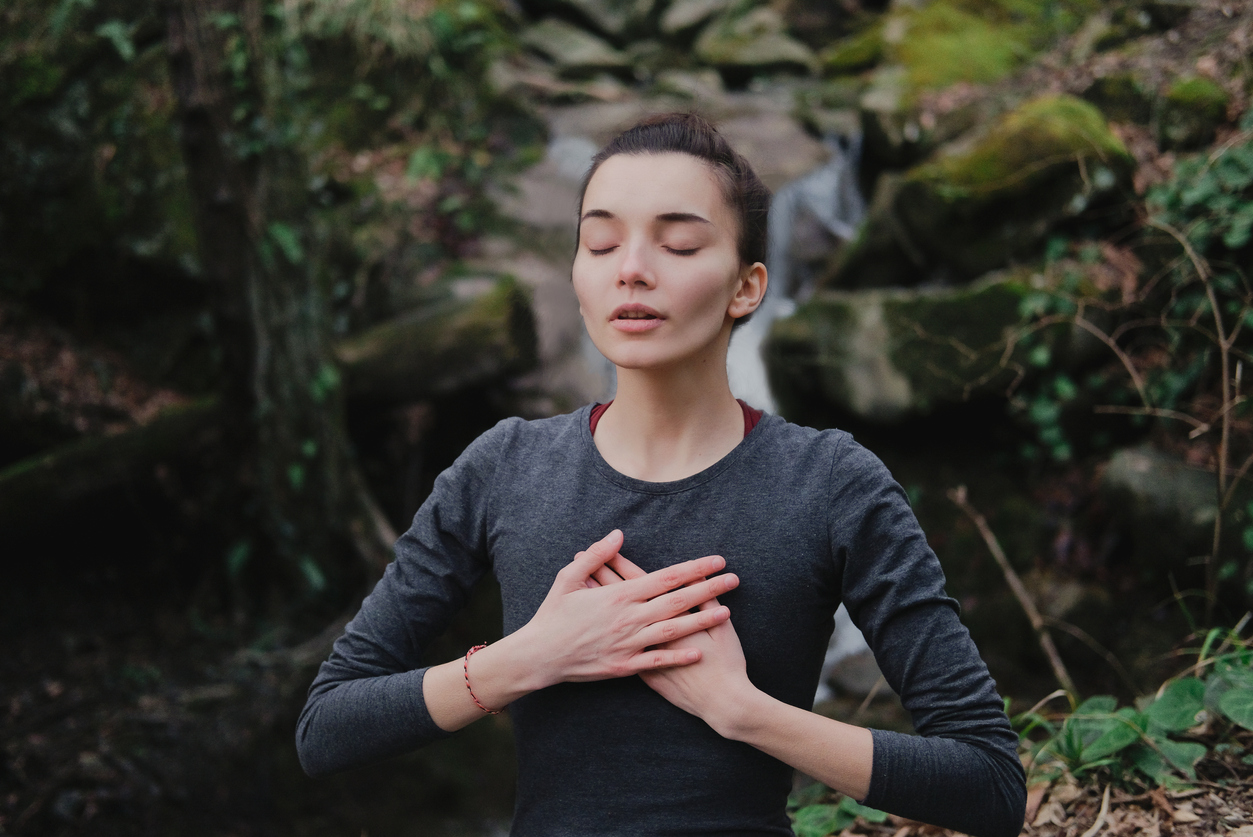One of the most powerful tools to reduce stress and anxiety is something you already have but probably don’t think about: your breath.
Many ancient healing modalities from around the world incorporate controlled breathing, from simple breath awareness practices to yogic breathing techniques. For centuries, practitioners across the globe have used the breath to still the mind and body and foster a sense of calm.
Better yet, there’s also plenty of modern evidence that controlled breathing techniques are associated with increased focus, reduced stress levels, and a host of other benefits.
To help you get started, here are several easy breathwork techniques that you can try at home. All you need is a comfortable seat, a few minutes, and, of course, your breath.
1. Belly Breathing
One of the simplest but most foundational breathing techniques is belly (diaphragmatic) breathing. It’s an excellent way to increase awareness of your breath. On its own, it can be a wonderfully calming exercise, but it’s also an important breath to learn in general. Getting used to belly breathing will make it much easier to take fuller and deeper breaths in other yoga, meditation, and breathwork practices.
How to do it:
- Find a comfortable seat with your back against a wall or chair.
- Place one hand on your upper chest and another on your belly.
- Inhale through the nose. Bring your awareness to the breath.
- The hand on your belly should move up with the inhalation, but the hand on your chest should remain still (or as still as possible).
- Repeat this cycle of inhales and exhales for five to ten minutes.
2. Box Breathing
Box breathing, also known as square breathing, is one of the most well-known breathwork exercises. It’s famously said to have been developed by U.S. Navy SEALs to calm down in high-stress situations. It’s a great way to reduce anxiety in the moment as you go about your day.
How to do it:
- Slowly exhale through your nose, making sure you get all of the air out of your lungs.
- Inhale slowly for a count of four, ticking off the seconds in your head.
- Now, hold your breath for a count of four.
- Finally, exhale for a count of four.
- At the bottom of the exhale, hold your breath for another four count.
- Repeat steps 2 through 5 as many times as you’d like. Ideally, try to breathe for at least two to five minutes.
3. Victorious Breath
Victorious breath, or “Ujjayi Pranayama,” is a breath practice in yoga that’s used to both energize the body and anchor the mind. You may be familiar with it from flow yoga classes, where it’s used to connect various poses in a fluid fashion, but you can practice it as a standalone technique.
How to do it:
- While sitting, inhale and exhale deeply through your mouth.
- After you’re comfortable, start to constrict the back of your throat slightly as you exhale. Imagine you’re trying to fog up a mirror. It should sound like a “haa” sound, or a bit like Darth Vader breathing.
- Once you get the hang of the breath on the exhale, you can add the slight constriction to the inhale. The breath should have an ocean-like quality to it, like waves at the beach.
- When you’re comfortable in the breath, try it out with your mouth closed. You should still feel like you’re trying to fog up a mirror or window.
- Practice this breathing technique for at least five minutes.
4. Relaxing Breath (4-7-8 Breathing)
The 4-7-8 breathing technique is a relaxing breathwork practice based on yogic exercise and developed by Dr. Andrew Weil. While it’s similar to other breathing techniques on this list, it really focuses in on lengthening the exhalation, which is said to “hack” the vagus nerve and counteract fight-or-flight stress.
How to do it:
- In a comfortable seat, inhale deeply and quietly through your nose. Mentally count to four.
- Now, gently hold your breath for a mental count of seven.
- Part your lips slightly and completely through your mouth with a “whooshing” sound for a total count of eight.
- Inhale again for four seconds.
- Repeat the cycle for several minutes.
5. Alternate Nostril Breathing
Alternate nostril breathing is another yogic breath technique that’s associated with lower perceived levels of stress and plenty of other positive benefits for your mind and body. It’s a beautiful way to still a racing mind before a meditation practice, but you can also use it anytime for a quick boost of calm.
How to do it:
- On your right hand, fold your index and middle finger toward the pad of your thumb. Your thumb, ring finger, and pinky should be sticking out.
- Take a few deep breaths through your nose.
- After an exhale, use your thumb to close your right nostril.
- Slowly inhale through the left nostril.
- Now, remove your thumb from your right nostril and use your ring finger to close your left nostril.
- Exhale through your right nostril.
- After a beat, inhale through the right nostril.
- Remove your ring finger from your left nostril and use your thumb finger to close the right nostril.
- Exhale through the left nostril.
- Again, inhale through the right nostril.
- Repeat for three to five minutes.
Breathing Your Way to Calm
The breath is an excellent tool to incorporate into your daily self-care practices because it’s something we always have with us. It’s free, always accessible, and can have a nearly immediate impact on your state of mind.
While it can be used as a complement to other practices, such as yoga and meditation, it may be at its most useful when you’re feeling particularly stressed. The next time you’re on edge or anxious, just take a few minutes and breathe through it.
As yoga teacher B.K.S. Iyengar once said, “regulate the breathing and thereby control the mind.”
Mike Peterson is a writer, editor, and yoga teacher based in San Diego. An advocate for mindfulness and meditation, he’s continually in pursuit of mental clarity and resilience. Read more of Mike’s articles at https://themikepeterson.











Join the GloWell Community on Social!
Don't risk missing a single thing. Follow us on social and become part of the GloWell community.